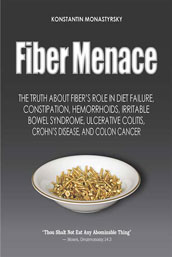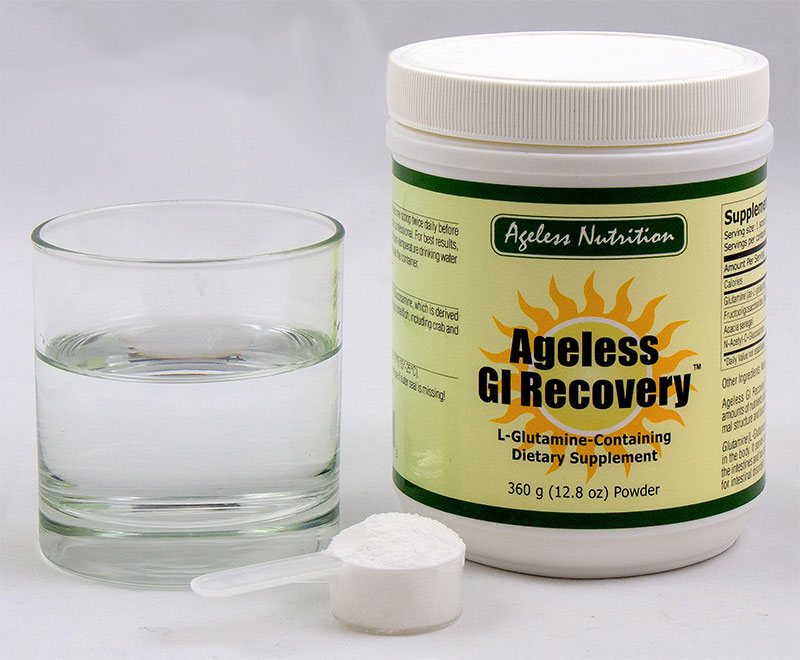GI Recovery (L-Glutamine-based Prebiotic)
Pharmaceutical-grade L-Glutamine formula for intensive gastrointestinal recovery and treatment of acute dysbacteriosis. Serves as prebiotic for innate and supplemental flora. Facilitates the healing and integrity of the intestinal mucosal membrane. Robust mucosal membrane is essential for the normal functioning and survival of the intestinal flora.

I‘ve been recommending Ageless GI Recovery to my readers and clients since 2000. It has been specifically formulated for rapid intestinal recovery, to improve the retention and survival of intestinal flora on low-fiber diets, and for conditions listed in the sidebar on the right. This supplement is manufactured in the United States from pharmaceutical-grade (USP) L-Glutamine.
Healthy intestinal bacteria reside and procreate inside the protective layer of the mucosal membrane, and derive their nutrients from mucus. To give a good home to existing bacteria and provide a head start to supplemental flora, your mucosal membranes must be healthy and well-nourished.
| 60 Servings per Container | Serving Size: 1 Scoop (6 grams) |
| Amount Per Serving | % Daily value |
| Calories | 30 | |
| Glutamine | as USP L-Glutamine | 5,000 mg * |
| FOS | as NutraFlora® FOS** | 250 mg * |
| Acacia Senegal | soluble dietary fiber | 500 mg * |
| NAG | N-Acetyl-D-Glucosamine | 250 mg * |
| * Daily value not established. ** NutraFlora is a registered trademark of Golden Technology Company, Inc. |
||
| OTHER INGREDIENTS: None | ||
| CONTAINS NO yeast, corn, wheat, gluten, soy, dairy, sodium, starch, sugar, wax, artificial colors, preservatives, or flavoring. | ||
For this reason GI Recovery contains small quantities of FOS (fructooligosaccharides) and acacia fiber, natural soluble fibers which are preferred by normal flora, but do not “appeal” to pathogenic bacteria. In small amounts, neither cause the bloating or flatulence associated with fiber in food and/or laxatives.
It also includes N-Acetyl-D-Glucosamine (NAG)—a naturally occurring amino sugar which helps in maintaining the intestinal mucous production. NAG is derived from the exoskeleton of shellfish (crab, shrimp, lobsters), and should be avoided by people with confirmed allergies to shellfish. In this case you may take pharmaceutical-grade L-Glutamine instead.
I only use the GI recovery glutamate powder. I think it helps but don't really know for sure. I think it helps make space for a healthy microbiome but I don't think I can do without it yet which makes me question whether it is healing my gut or just helping eliminate symptoms but not an actual cure. L.G. (via survey)
GI Recovery is recommended for inflammatory intestinal conditions. It facilitates the healing of the mucosal membrane essential for the treatment and/or prevention of pain, bloating, obstruction (due to inflammation), ulceration, bleeding, and possible progression into ulcerative colitis or Crohn‘s disease. The following excerpt from Fiber Menace explains how l-Glutamine accomplishes these goals:

The amino acid glutamine is the principal metabolic fuel for the intestinal mucosa, or, more specifically, for the cells that line the intestinal epithelium (enterocytes). For this reason, the small and large intestines require more glutamine than any other organ.
A deficiency of glutamine causes atrophy of the intestinal mucosa, a condition commonly associated with chronic enteritis, irritable bowel syndrome, ulcerative colitis, and Crohn‘s disease. All of these disorders, in turn, are associated with chronic constipation, something you want to prevent and avoid during the transition [to a low fiber diet - ed.].
Glutamine is readily synthesized in human cells. It is also the most prevalent amino acid in intestinal tissue, blood, skeletal muscles, the lungs, liver, brain, and stomach. When the demand for glutamine exceeds the internal supply—because of trauma, disease, infection, medical treatment, digestive impairment, dietary deficiency, starvation, and similar circumstances—the body must get it from the diet or from supplements. For this reason glutamine is designated as a “conditionally essential” amino acid.
Just like with any other amino acid (except essential), when the diet lacks the adequate amount of protein required to synthesize glutamine, the body draws it from itself. Muscle and bone-wasting (i.e. osteoporosis) is one of the first and most prominent symptoms of acute glutamine deficiency.
Meats, fish, poultry, dairy products, and beans are the main dietary sources of glutamine for people with normal digestion. Because beans cause flatulence and bloating related to their high-fiber content, they are an inappropriate source of glutamine for anyone but the young and healthy.
For people who already suffer from intestinal disorders, regular diets can‘t provide adequate glutamine regardless of the source, because they have difficulties digesting dietary protein to begin with. Ironically, this impasse is caused in part by... glutamine deficiency. There is only one way to break this vicious cycle: by using glutamine in supplemental form.
Glutamine supplements are available in three forms: (1) as L‑Glutamine, a free-form amino acid, which means it‘s identical to the glutamine present in the body; (2) as glutamine peptides, which means it's bound with other amino acids; and as (3) a mix of both.
Glutamine peptides are considered more stable during storage, but are known to cause constipation and bloating, and are contraindicated for people with kidney disease, and women who are pregnant or nursing. For these reasons glutamine peptides aren‘t appropriate for the treatment of constipation and digestive disorders.
There are no known side effects associated with pharmaceutical-grade supplemental L-Glutamine, because, as has been already said, it is identical to naturally-occurring glutamine in the body, and doesn‘t need to be predigested, as glutamine peptides do.
Glutamine supplements are especially popular among athletes and body builders, and are broadly available in health food stores in the form of water-soluble powders, tablets, or capsules. Depending on the degree of intestinal damage, you may require from 5 to 10 g of L-Glutamine daily, hence neither tablets or capsules are practical or economical for this purpose.
Pharmaceutical-grade L-Glutamine is best for supplementation because of its purity and exceptional digestibility (bioavailability). For best results it must be taken on an empty stomach, so it gets down into the intestinal tract without being held up by gastric digestion. Most of the supplements for athletes sold in health food stores contain food-grade L-Glutamine, or are mixed with glutamine peptides.
Fiber Menace, p. 240-242
GI Recovery is an excellent complement to V.L.C. (very low calories) diets for similar reasons—it prevents protein malnutrition (usually apparent in muscle wasting, bloating, edema, depression, insomnia), and calms down hunger, cravings, and low blood sugar—all the usual diet-breakers. Besides, when the diet is over, you aren't sick, malnourished, and starving, ready to yo-yo back to the old you.
GI Recovery is particularly useful in critical care nutrition (pre- and post-surgery, severe burns, trauma, gastric bypass, gastectomy, chemotherapy, partial GI obstruction, and similar. In all these instances, critical patients experience a profound need for proteins, but are unable to consume, digest, and assimilate any. I recommend to dissolve GI Recovery powder in all liquids, including drinking water, broth, tea, coffee, and other beverages. It also works well for children because its practically imperceptible.
This approach prevents gradual wasting of intestinal mucosa and enterocytes (nutrient-absorbing cells), and alleviates acute protein deficiency, typical for clear-liquid diets. This way patients recover faster, experience less secondary side effects, are more resistant to opportunistic infections, and are able to resume normal nutrition as soon as they begin eating solid food, because their GI tract mucous membrane is nearly intact after an extended fast.
Please note that GI Recovery itself doesn't provide essential amino acids, only L-Glutamine. For long-term critical care nutrition you must also add balanced essential amino acid liquid formulas, such as Pro-Stat 64 or Twinlab's AminoFuel.
I only purchased GI Recovery and appreciate that it truly does seem to prepare my gut for food. And seems to be healing my gut. I don't know how the prepared tablets work...as I hesitate to take even tablet vitamins. I don't seem to be able to digest them without discomfort. Maybe later when I need to order more of these two products, I'll get the entire program. H.B. (via survey)
How to take GI Recovery
Take GI Recovery on an empty stomach, before food, so it can quickly pass through the stomach into the small intestines without being exposed to digestive juices. This assures fast assimilation, and strengthens the intestinal mucous membrane before the onslaught of bile, gastric acids, and enzymes.

A single dose of GI Recover powder in the scoop.
It is provided inside the container.
GI Recovery dissolves quickly and easily in warm fluids, and despite L-Glutamine being an amino acid, the solution itself is only mildly, almost non-perceptibly, acidic, and mild on the stomach.
Taking GI Recovery along with Hydro-C program is perfectly fine. Just don't mix both in the same glass because you do need extra water to assimilate these supplements and to offset the loss of fluids with stools when using Hydro-C program as a softener and moisturizer.
Critical care patients may take GI Recovery round-the-clock with all liquids. Always consult an attending doctor before giving this or any other supplement to a patient. If the doctor tells you not to provide it, always ask why. Some physicians may dismiss your request simply because they may be too busy to investigate it. In this case seek a second opinion or appeal to supervising staff.
I haven't felt this good in my life. The abdominal torture I've endured for as long as I can remember is just a memory . Hydro-C program and GI-Recovery taken every morning has set me free. My deepest gratitude.D.E. (via email)
Amazing products. My 4 months long diarrhea stopped after only two doses of Ageless GI Recovery. Many thanks to Konstantin Monastyrsky. I still take GI Recovery at maintenance doses for almost a year now to keep my gut lining strong and healthy and I feel thousands of times better.A.V. (via survey)
I have read Mr. Monastyrsky's entire website thoroughly, more than once. The knowledge I gained there has made a big difference in my own life, and in the health of and my understanding of my gastrointestinal tract. I use the L-Glutamine supplement and probiotics daily and both have been so beneficial that I don't often need to use Hydro-C.C.M. (via survey)
I take the Hydro C and the GI Recovery only. I am very pleased with these two products and feel they have helped me so much more quickly than anything I have ever tried for constipation. It is easy and gentle which is exactly what I needed after dealing with all the other previous digestive issues of pain and discomfort.W.M. (via survey)
Fabulous! My son has been on Exlax, enemas and Miralax for 2 years and the dr/NNP had no other options for us. His underwear cleared up the week he started using the Hydro-C program and GI recovery! Amazing! So glad it's natural too!C.S. (via survey)
This information has not been evaluated by the Food and Drug Administration. This product is not intended to diagnose, treat, cure or prevent any disease.
